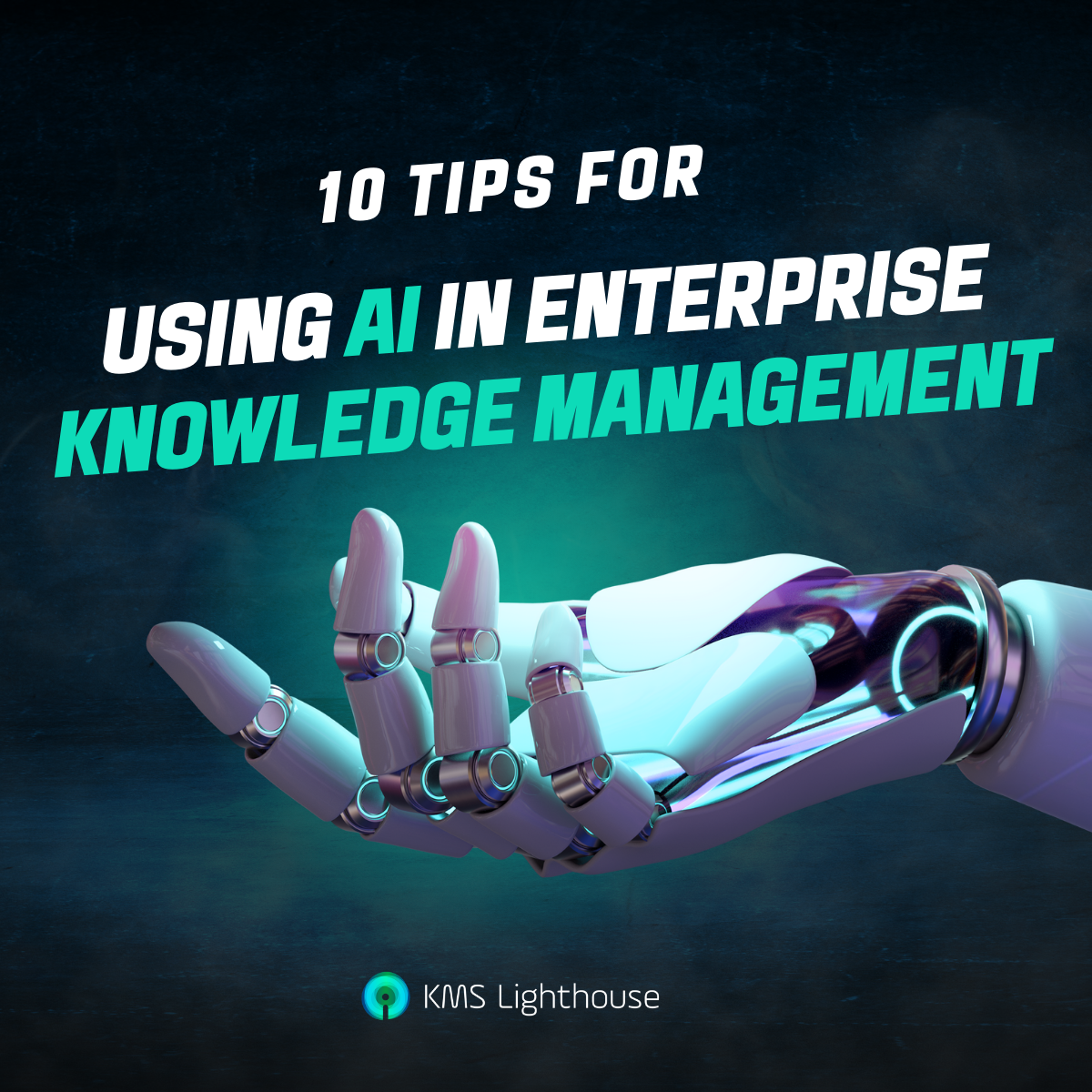By incorporating AI into your KM system, you can:
- Align marketing efforts with targeted audiences.
- Offer 24/7 self-service customer support options.
- Reduce hold times with real-time responses to user queries.
- Resolve problems swiftly, minimizing conflicts and building trust.
AI also helps identify gaps in existing knowledge bases and predict potential deficits. And its multilingual capabilities mean you can offer support to diverse customer bases. It also accelerates training and onboarding processes, making it easier for new team members to get up to speed.
If you want an innovative way to transform the customer experience while positioning yourself as an industry leader, incorporating AI into your KM system can be the solution you need to drive efficiency and strategic foresight to unprecedented heights.
10 Tips for Using AI in Enterprise Knowledge Management
Combining AI with KM is changing how enterprises gather, use, and manage their knowledge bases. It helps them improve task efficiency, make better decisions, and improve their knowledge discovery and retrieval. It’s also a terrific tool for boosting customer satisfaction, helping customers get relevant, useful responses from self-service solutions and live agent assistance.
It’s safe to say that integrating AI and KM is shaking up the very nature of information handling. From streamlining data access to enhancing customer interactions, it’s helping organizations foster innovation and deeper connections with their customers and clients.
Ready to start on your AI-driven enterprise KM journey? Here’s how to get the ball rolling.
1. Begin with the Basics
Start with learning about AI’s basic concepts, such as machine learning, natural language processing (NLP), and neural networks. These are the building blocks that will shape your AI integration.
- Machine learning is the engine driving AI’s ability to learn from data.
- NLP is the key to AI’s understanding of human language.
- Neural networks mimic the human brain’s learning process (but they do not think for themselves).
You can then choose a platform that aligns with your enterprise’s needs and requirements.
If, like most people, you’re not as fluent in AI as you’d like to be, there are many online AI “boot camps” and self-paced technical courses you can enroll in or watch. The goal is to learn how to collaborate with AI, keeping in mind the technology is a tool, not a human replacement.
2. Learn the Ropes
To truly maximize the potential of your chosen AI platform, you’ll want to dive deep into its capabilities to unlock its full potential. For instance, if your enterprise uses AI-powered chatbots, understanding their capabilities and limitations can help you design efficient workflows, automate routine tasks, and deliver timely responses. There are no shortcuts when it comes to educating yourself on AI’s potential, but by choosing a platform that offers engaging webinars, articles, tutorials, and videos, you can acquire the knowledge needed to harness its power effectively.
3. Optimize Efficiency
Picture AI models as finely crafted instruments you can adjust to play the perfect tune for your KM processes. To ensure AI models suit your organization’s unique requirements, use NLP to extract, categorize, and summarize knowledge. To streamline workflows, integrate AI with your existing KM tools, including CRMs, CSMs, and chatbots or virtual assistants. You’ll save valuable time and resources and ensure AI elevates your KM processes to their full potential.
You’ll also want to establish user feedback loops and routinely review and clean the knowledge database to remove outdated information and train and improve AI models.
4. Integrate Seamlessly
If there’s one key to unlocking AI’s full potential in KM, it’s integrating it into your existing KM tools and processes. By incorporating AI tools with your CRM, CSM, or chatbot, you create a symphony of streamlined processes.
This seamless integration enhances efficiency and provides an overview of customer interactions and KM, allowing for better decision-making. It also enables a comprehensive approach to managing knowledge, making it a vital strategy for staying competitive and innovating in a rapidly evolving digital landscape.
5. Enhance Knowledge Management
How you manage and share information is just as important as gathering it. Picture AI as your enterprise’s trusted librarian, tirelessly categorizing and updating your knowledge resources. To ensure people get the information they need, they train AI models to provide relevant and context-aware data. They also keep the system updated with the latest industry trends and insights to ensure your library stays current.
Security is a top priority, so encryption, access controls, and regulatory compliance are always on the radar, ensuring your knowledge assets’ confidentiality and integrity and safeguarding them against potential threats and breaches.
6. Promote Continuous AI Learning
Here, you empower your AI system to learn from user interactions, much like having a human assistant who becomes more knowledgeable with each exchange. You can also optimize the system to deliver rapid and accurate search results, making accessing critical knowledge effortless for your teams. As AI continually adapts and evolves to meet your enterprise’s shifting needs, it fosters a dynamic and user-friendly KM experience that promotes efficiency, innovation, and collaboration while driving your enterprise toward greater success in a knowledge-driven landscape.
7. Monitor Performance
Effective AI KM requires vigilant performance monitoring. Metrics like response time, accuracy, usability, and information quality should be tracked to maintain consistent performance. Regular assessments and refinements identify areas for improvement and ensure your KM processes remain efficient and effective. Think of this step as keeping your car’s engine well-tuned to achieve peak performance. It makes sure your AI system continues to meet and even exceed expectations as it serves your enterprise and its customers.
8. Train and Fine-Tune
Incorporating new data and feedback into your AI model can improve its KM capabilities, accuracy, and effectiveness.
AI models are not static; they can evolve and improve over time, provided you engage in a continuous cycle of training and fine-tuning. Much like a gardener must constantly nurture their plantings to achieve the most vibrant and fruitful results, you must continually introduce new data and feedback to boost AI’s results.
9. Implement Version Control
Successfully managing AI models and knowledge databases involves maintaining version control. Version control is the history of your AI’s development. It makes it easier to track and manage changes in projects and ensures you maintain a reliable and consistent KM system, even as updates and adjustments are made. A detailed roadmap of your AI’s journey, it enables you to navigate smoothly through alterations and improvements, safeguarding against unexpected road bumps and ensuring a seamless KM experience.
10. Test and Measure
Creating test scenarios and measuring your AI system against real-life scenarios helps you track its performance and identify areas for improvement.
Rigorous testing and measurement are crucial to the success of AI-driven knowledge management. This quality assurance step ensures your system performs flawlessly and lets you gauge its effectiveness, identify its strengths, and pinpoint areas for improvement. Create test scenarios that closely mimic real-life situations to get a clear view of how your system responds.
Implementing AI for Knowledge Management
In addition to these ten tips, you also want to keep current with AI advancements and knowledge management techniques and approaches. This can include attending conferences, participating in webinars, and reading or listening to leading experts to stay informed.
Lastly, encourage your team to adopt the AI-based knowledge base by offering training sessions, clear guidelines, and support materials.
From a practical standpoint, when it’s time to implement AI in your enterprise knowledge management:
- Start small and scale up as you gain experience and confidence.
- Get buy-in from all stakeholders to help ensure the model is used effectively and its outputs are accurate and trustworthy.
- Continue regular monitoring and evaluation, and make necessary adjustments and improvements.
Implementing AI for knowledge management is a journey that requires careful planning and ongoing commitment. Starting with small-scale projects lets your organization gain valuable experience and belief in AI’s capabilities. Buy-in from all stakeholders ensures user acceptance and alignment with organizational goals. And continuous monitoring helps to improve accuracy, provides quality assurance, and identifies potential compliance issues.
Work Smarter and Remain Competitive With AI for Enterprise KM
Still not sure if an AI-powered solution can help you achieve your enterprise’s knowledge management goals?
KMS Lighthouse customer TechStyle Fashion Group, a global fashion commerce organization headquartered in Los Angeles, illustrates how automation can be a game changer for agents and customers alike. Before implementing Lighthouse, the company used a basic search functionality that resulted in extensive loading times and limited user experiences. Literally thousands of customer care agents were accessing siloed information to provide customer service.
Two months post-implementation, agents had fast and easy access to one source of truth in providing customers with the fast, personalized service they demand and deserve. And all it took was one day of training and onboarding to get agents up to speed. Today, 100% of them use the knowledge base daily.
If you want to improve agent efficiency and boost customer experience at the same time, incorporating AI into your enterprise knowledge management helps you effectively reduce the time it takes to solve issues and stay attuned to evolving customer needs.
At KMS Lighthouse, we know how critical the right tools are to a successful KM strategy. With its user-friendly interface and seamless collaboration features, Lighthouse makes it easier than ever to share knowledge with team members and customers. Get in touch with us today to learn more about how an AI-based knowledge management solution can help your enterprise harness this exciting technology’s full potential.







